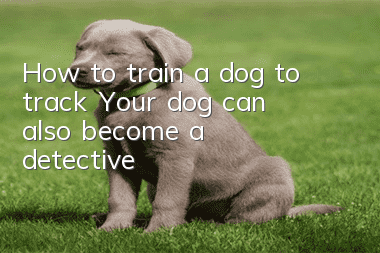How to train a dog to track? Your dog can also become a detective

Train the dog to track
According to the command of the dog owner and the smell of the source of smell given to it, look for the same trace as the smell of the source, and follow this trace Line tracing to obtain items and people with the same scent as the source. The dog is required to be excited about work, active in sniffing, steady on the line, strong in tracking, and responsive.
【Suitable age】8 months-12 months
[Training Goal] Cultivate the dog's ability to track targets based on scent traces.
[Training Tools]Tracking straps, tracking items
【Training Difficulty】★★★★☆
[Training steps]
1. The first thing is to get the dog used to wearing a tracking rope and a tracking harness. Afterwards, choose a suitable small piece of grass, pull the leash to let the dog sit down, and another person walks in a straight line about 45 meters away, and puts familiar items on the ground to ensure that the dog can see what it is doing. After these actions, put the tracking harness and leash on the dog, bend down and point to the starting point with your right hand, and give the "sniff" and "track" commands. The dog will be very excited to rush forward because it sees the items placed. At this time, after repeated training by the dog trainer, the dog will gradually develop the ability to stand according to gestures or commands and last for a certain period of time. On this basis, the dog will be trained to learn to perform actions such as bowing and turning in circles.
2. Before training begins, put a tracking belt and tracking rope on the dog. Hold the rope by its shoulders. Place your right hand on the starting point and give the dog a "sniff" and "track" command. When the dog starts tracking, let the rope slip through his hand and follow him until about 0.9 meters remain. If your dog is behaving well, give him gentle encouragement from time to time. Use daily commands when the dog loses interest or simply won't track. When the dog finds something at the end of the trail, it should reward the child by removing the tape and throwing it out to catch.
3. The second step is to enter the second stage of training. When the dog tracks successfully with a delay of 10 minutes, in addition to placing items at the end point, items can also be placed halfway. There should be a certain distance between items. The items in the middle should be placed on the trace line. deviation, and do not place on or near turns. Don’t make items too large or conspicuous. At the same time, it should be fully exposed to the smell of human body. Start with 3 items. As the training progresses, the tracking distance gradually extends and the number of placed items can be increased.
4. Finding placed objects is beneficial to improving the dog's tracking ability because it causes the dog to make full use of its sense of smell. Once the dog finds the tracked item, he should lie down, drop the tracking rope on the track, run to the dog's side, and encourage him as usual. After receiving the item from the dog, grab the tracking rope on the dog's shoulder and say "Track"o; command, when the dog chases forward again, let the rope slide through the hand as mentioned above. As the training level increases, when the dog finds an object, he will take the initiative to lie down.
5. Then enter the third stage of tracking: when the dog is asked to extend the scent for 20 minutes, training on right-angle traces should be arranged, with at least 50 steps between inflection points. As mentioned before, items should not be placed around corners or corners.
6. Due to various reasons, such as the smell of people or livestock passing by, changes in geological conditions, the impact of working under strong winds, etc., it is difficult for dogs to track. At this time, the dog owner should lead the dog a few meters forward, or move the dog a few meters to the left or right and try again, allowing it to squeeze the trace and continue tracking. If your dog fails to track, arrange a simpler one and don't let him lose interest. Two successful training sessions per week should be ensured. After correct and alert training, the dog will eventually be able to follow traces that are delayed for several hours.
- What do dogs eat to protect their stomach? It is important to protect their stomach and treat gastrointestinal diseases in dogs.
- How to tell if your dog is fat? Is your dog overweight?
- Will your dog catch a cold if you blow the air conditioner? What should you do if your dog catches a cold if you blow the air conditioner?
- What should you pay attention to when your dog drinks water? Don’t be careless when it comes to your dog’s drinking water.
- The dog's mouth bites and shakes. Why does the dog's mouth occasionally shake and bite?
- How to cut a dog's hair? Do you know how to cut a dog's hair correctly?
- Can dogs eat raw eggs? Why can’t dogs eat egg whites?
- Common Dog Problems in Summer How to Deal with Different Dog Problems
- How to keep dogs away from skin diseases. If you do this, will you see if your dog will still be infected with skin diseases?
- What causes anorexia in dogs? Dogs will become anorexic due to lack of exercise. Hounds run at least 5KM every day.



